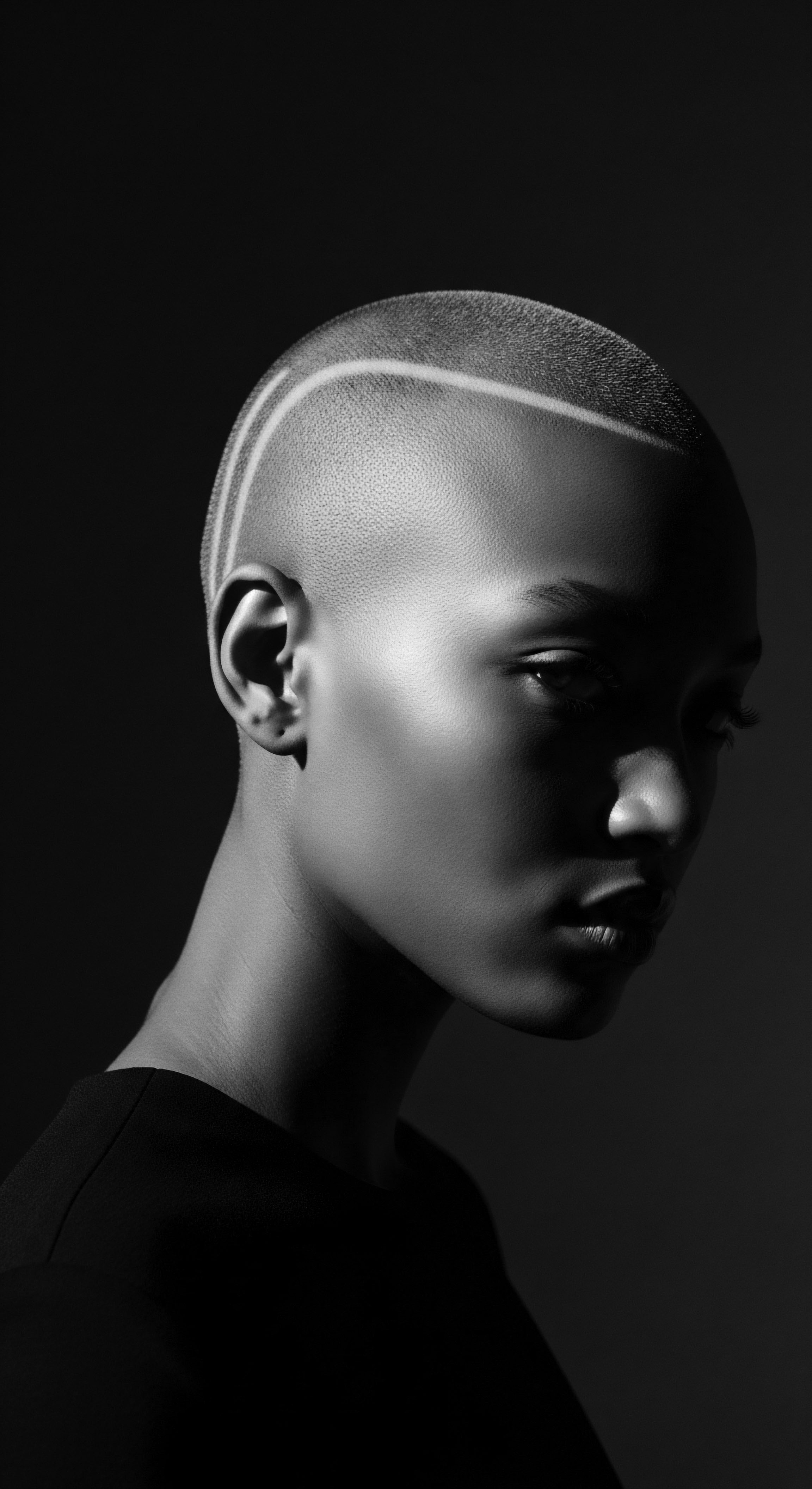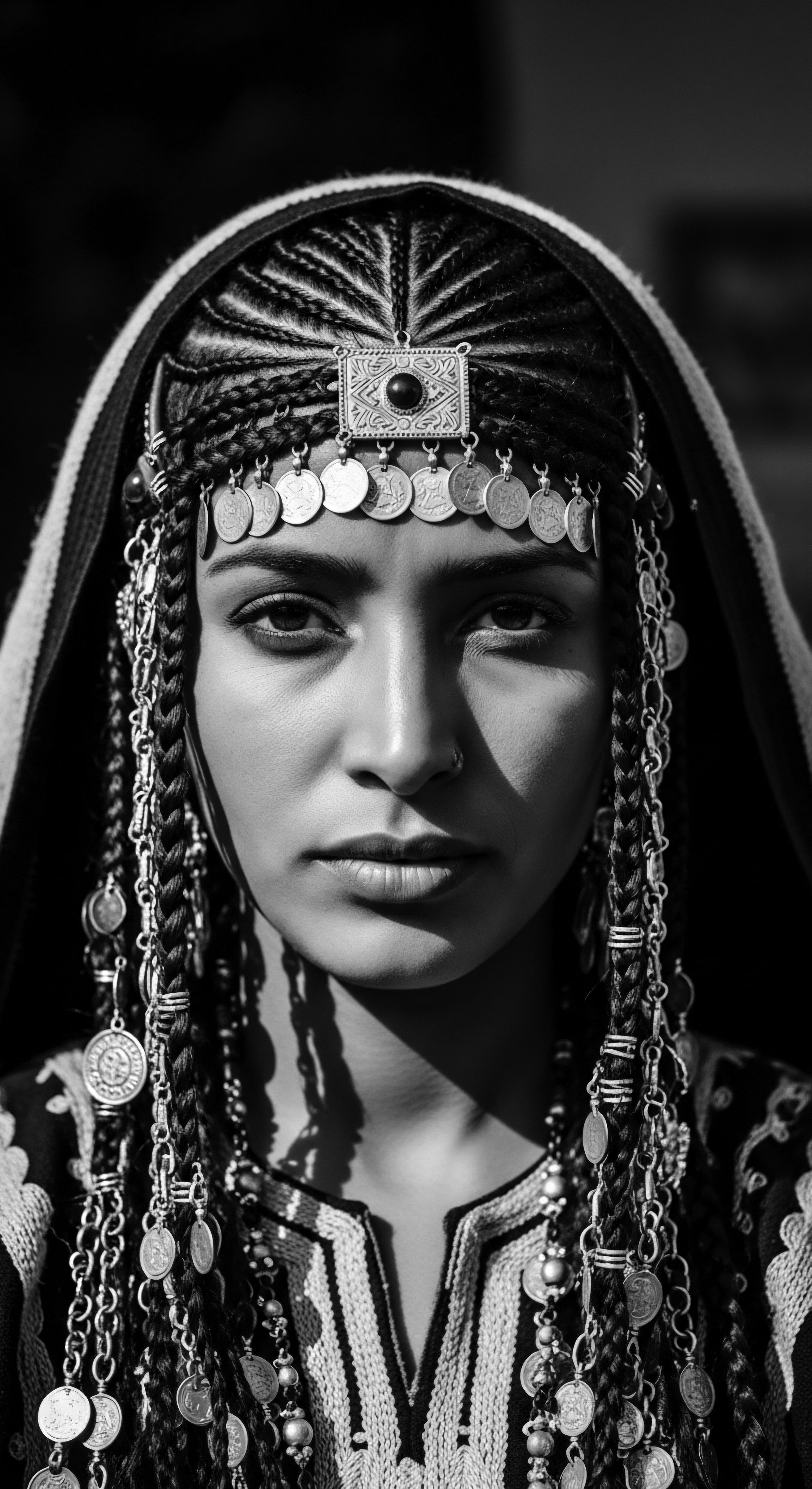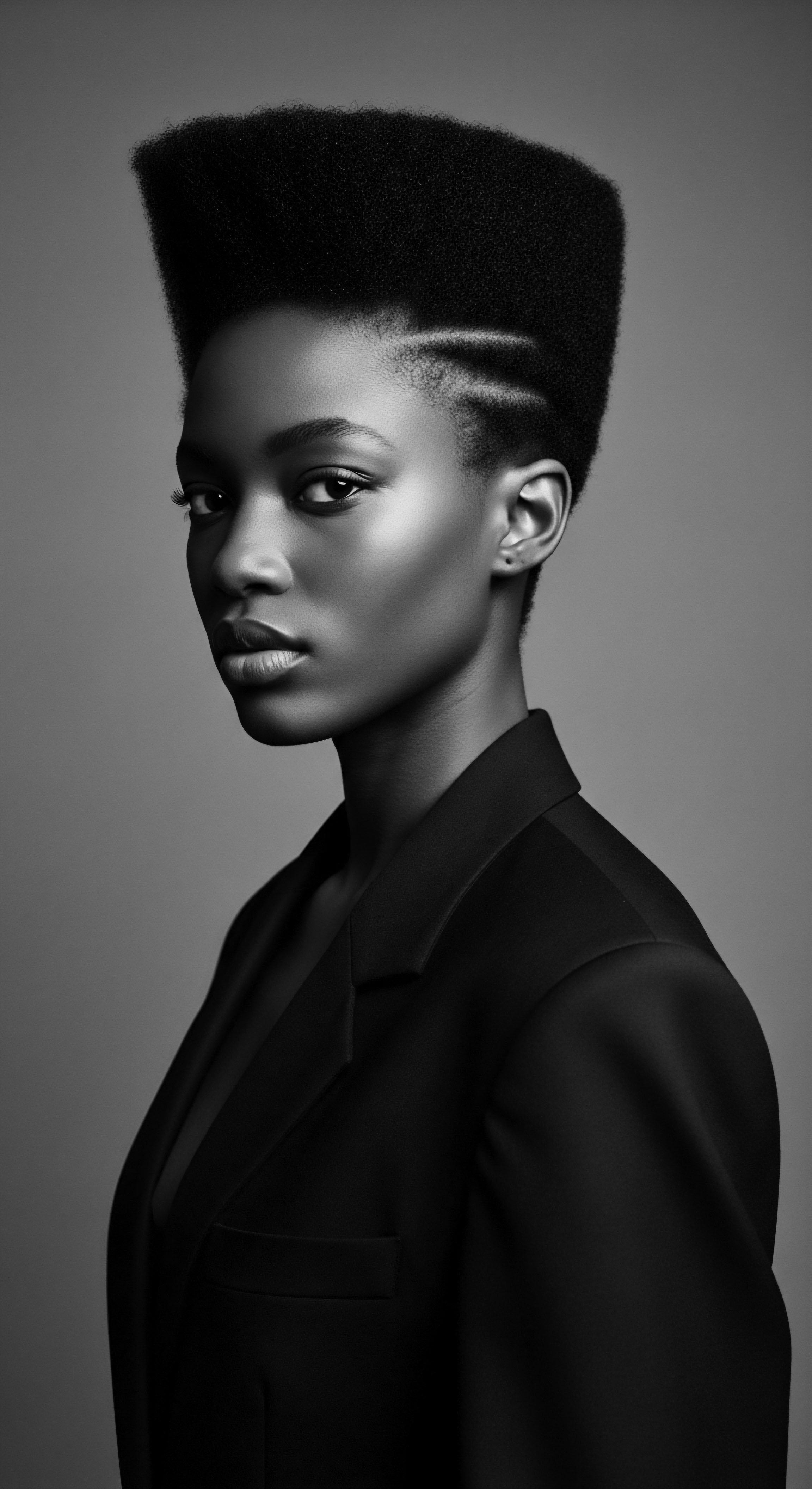
Fundamentals
From the earliest whispers of dawn to the quiet descent of twilight, our hair, particularly textured hair, has always been intimately bound to the world around it. The very notion of the Environmental Elements, when viewed through the lens of ancestral wisdom and the lived experiences of Black and mixed-race communities, extends far beyond mere atmospheric conditions. It encompasses every external influence, every tangible and intangible force shaping the vitality, appearance, and historical trajectory of our crowns.
This initial contemplation begins with understanding the straightforward definition ❉ Environmental Elements are the various factors originating from an external milieu that interact with, and thus leave an impression upon, biological structures, including human hair. For those seeking clarity on hair’s journey, this explanation serves as a first step.
Consider, for instance, the sun’s persistent rays, capable of altering moisture levels and pigment. Think, too, of the subtle dance of humidity, sometimes a balm, other times a challenge, dictating a coil’s elasticity. Particulates carried by the wind, the quality of water used for cleansing, even the very air we breathe—each plays a quiet, yet persistent, role.
These are the physical realities that touch each strand, from root to tip, carrying with them consequences for hair health and styling choices. Through a heritage perspective, these physical elements were not just challenges; they were teachers, guiding our ancestors to develop ingenious practices for hair care and preservation.
Environmental Elements signify all external influences, from the palpable physical world to the unseen cultural currents, that shape textured hair’s vitality and historical path.

The Sun’s Caress and Challenge
The sun, a giver of life, also brings its own set of considerations for hair. Its ultraviolet (UV) radiation can affect the delicate protein structure of hair, leading to a reduction in its inherent strength and flexibility over time. For centuries, our forebears, particularly those living in sun-drenched regions, observed these changes.
They learned to protect their hair, often through elaborate styling methods or by incorporating natural shields from their surroundings. This practical knowledge, honed over generations, reflects a deep comprehension of how external forces could alter hair’s inherent nature.
Melanin, the pigment responsible for hair’s deep hues, offers some natural defense against solar exposure. However, prolonged exposure can still lead to a loss of moisture, rendering strands more brittle. Traditional practices, like coiling hair close to the scalp or adorning it with headwraps fashioned from breathable fabrics, provided a physical barrier, a testament to inherited wisdom in safeguarding hair from the elements. These methods were not merely aesthetic; they were functional, born of necessity and deep observational learning within specific environments.

The Breath of Humidity and Dryness
The atmospheric moisture content, known as humidity, presents a dual influence upon textured hair. In environments with high humidity, hair, particularly those strands with high porosity, may absorb moisture from the air, causing the hair shaft to swell. This swelling can lead to an increase in volume and the phenomenon often referred to as frizz, where individual strands seek their own path.
Conversely, arid conditions draw moisture away from the hair, leaving it feeling dry, brittle, and susceptible to breakage. Ancestral communities, acutely attuned to their local climates, developed distinct regimens to contend with these atmospheric variations.
In some African regions, where humidity often prevailed, hair care practices might have focused on cleansing routines that maintained scalp health without stripping natural oils, paired with styles that managed volume while allowing air circulation. In drier climates, the emphasis might have shifted towards rich emollients derived from local plants, substances designed to seal moisture into the hair shaft and guard against dehydration. The practical application of such knowledge represents a sophisticated, empirically driven understanding of hair’s interactions with its immediate surroundings.
- Moisture Retention ❉ Applying plant-based oils and butters to seal hydration within the hair strand, a common practice in dry climates.
- Scalp Wellness ❉ Utilizing specific clays or herbal rinses to cleanse the scalp and hair without over-drying, common in humid regions.
- Protective Styling ❉ Braiding, twisting, and knotting hair close to the scalp to minimize environmental exposure and retain moisture.

Intermediate
Moving beyond the primary physical influences, an intermediate comprehension of Environmental Elements within textured hair heritage delves into the intricate relationship between ecological contexts, material resources, and the evolution of care rituals. This signifies how the physical environment, particularly its native flora and fauna, directly shaped the available palette of hair care ingredients, and subsequently, the ancestral practices that defined hair health and beauty. It is a consideration of the inherent significance each botanical offered, a testament to the intimate connection between the land and its people’s traditions.
The meaning of Environmental Elements deepens as we consider how distinct biomes yielded specific natural emollients, cleansers, and fortifiers. For instance, the shea tree, Vitellaria paradoxa, indigenous to West Africa, became a cornerstone of hair and skin care across numerous ethnic groups. Its butter, rich in fatty acids and vitamins, offered unparalleled protective and moisturizing qualities.
Similarly, aloe vera, various clays, and specific essential oils—each unique to its geographical origin—were integrated into hair care arsenals, becoming indispensable tools for managing hair’s response to its surroundings. This historical reliance on regional botanicals underscores a profound, reciprocal relationship with the environment.
The environmental landscape directly influenced ancestral hair care, with indigenous botanicals shaping practices and becoming symbols of communal knowledge.

Water’s Varied Touch
The quality of water used for hair cleansing represents a significant environmental factor, its impact often subtle yet persistent. Water hardness, determined by the concentration of dissolved minerals like calcium and magnesium, can affect how cleansing agents perform and how hair feels post-wash. Hard water can lead to mineral buildup on hair strands, potentially leaving them feeling dull, rigid, and prone to breakage. This phenomenon might hinder the effective penetration of conditioners and moisturizing treatments, diminishing their restorative qualities.
Historically, communities developed clever methods to circumvent the challenges presented by their local water sources. Some relied on rainwater collection, recognized for its softness and purity, for essential cleansing rituals. Others employed natural softeners, perhaps by adding specific plant ashes or drawing from geological knowledge of local springs known for their softer output.
This adaptation to the immediate water environment underscores the resourcefulness of ancestral hair care, where practical chemistry was intuitively applied long before its formal scientific naming. This practical, experiential understanding of water quality informed generations of hair traditions.

Pollution’s Invisible Hand
Beyond natural elements, the advent of industrialization introduced new environmental elements ❉ air pollution. Particulate matter, microscopic dust, soot, and chemical contaminants suspended in the atmosphere, pose a modern challenge to hair. These pollutants can settle on the hair shaft and scalp, contributing to irritation, dryness, and a compromised appearance. Over time, this buildup can obstruct scalp pores, potentially hindering healthy hair growth and exacerbating existing conditions.
While our ancestors certainly contended with environmental dust and smoke from fires, the scale and chemical composition of contemporary pollution present novel pressures. Today, this understanding informs the renewed interest in deep cleansing methods and protective styling that minimizes direct exposure to urban environments. The concept of “environmental detox” for hair, therefore, holds a lineage that stretches back to ancient practices of purity and protection, now adapted to confront modern realities.
| Ingredient Shea Butter |
| Primary Environmental Origin West African Savannah (Vitellaria paradoxa tree) |
| Traditional Hair Care Use Moisturizer, sealant, protective barrier against sun and wind. |
| Modern Scientific Link (Heritage Connection) High in fatty acids (oleic, stearic), vitamin E, natural UV filter. Supports hair elasticity and moisture retention, mirroring ancestral observations. |
| Ingredient Aloe Vera |
| Primary Environmental Origin Arid/Semi-arid regions (Various Aloe species) |
| Traditional Hair Care Use Soothing scalp, conditioning, hydrating. |
| Modern Scientific Link (Heritage Connection) Contains enzymes, minerals, vitamins. Known for moisturizing and anti-inflammatory properties, validating its historical use for scalp soothing. |
| Ingredient Rhassoul Clay |
| Primary Environmental Origin Atlas Mountains, Morocco |
| Traditional Hair Care Use Gentle cleansing, detoxification, mineral enrichment. |
| Modern Scientific Link (Heritage Connection) Rich in silica, magnesium, calcium, potassium. Absorbs impurities while conditioning hair, providing a historical blueprint for gentle cleansing without harsh detergents. |
| Ingredient Palm Oil |
| Primary Environmental Origin Tropical regions of Africa |
| Traditional Hair Care Use Deep conditioning, adding shine, protective. |
| Modern Scientific Link (Heritage Connection) High in vitamin E (tocotrienols) and carotenoids, acting as antioxidants. Its ancestral use as a hair dressing parallels its contemporary recognition for nourishing and protecting the hair shaft. |
| Ingredient These ingredients represent generations of environmental attunement, where communities understood the bounty of their surroundings and its profound significance for hair care traditions. |

Academic
At an academic level, the Environmental Elements affecting textured hair transcend simple physical factors, demanding a rigorous, multi-disciplinary examination that uncovers their interwoven biological, socio-cultural, and historical dimensions. The definition here expands to encompass the comprehensive array of external influences, both natural and human-made, that shape the genetic expression of hair texture, the integrity of the hair shaft, and the complex adaptive practices of care developed by human populations, particularly those of African descent across the global diaspora. This interpretation acknowledges the profound significance of context—how environments dictate not only hair’s physical state but also its symbolic weight, its economic valuation, and its role as a marker of identity and resilience.
The meaning of Environmental Elements becomes a lens through which to comprehend the enduring dialectic between innate biological predisposition and external pressures. It is about how centuries of environmental shifts, forced migrations, and socio-political landscapes have irrevocably altered hair care paradigms, often necessitating remarkable ingenuity. This scholarly pursuit involves drawing insights from anthropology , environmental science , dermatology , and cultural studies to construct a holistic understanding of textured hair as a living archive of human interaction with its surroundings.
One compelling historical instance powerfully underscores the complex interplay of Environmental Elements and textured hair heritage ❉ the forced relocation of enslaved Africans during the transatlantic slave trade. This cataclysmic displacement wrenched individuals from their ancestral ecologies, where a sophisticated knowledge of indigenous plants and climate-adapted hair care rituals had flourished for millennia. Arriving in alien landscapes—the humid Caribbean, the arid American South, the varying climates of South America—Africans faced not only brutal dehumanization but also an unprecedented environmental shock to their hair and skin.
The transatlantic slave trade offers a poignant case study, revealing how forced environmental shifts dramatically reshaped textured hair care, necessitating profound cultural adaptation.

The Ecological Rupture of Displacement
In their homelands, hair care was intrinsically linked to readily available botanicals like shea butter, palm oil, and various herbal concoctions. These ingredients were culturally specific and biologically attuned to the demands of their native climates. The journey across the Middle Passage, followed by labor in harsh agricultural environments, meant exposure to intense sun, novel flora, and unsanitary conditions.
Crucially, the traditional implements and ingredients were no longer accessible. This environmental void compelled enslaved communities to adapt with astonishing resourcefulness, creating new hair care strategies from the scarce resources at hand, often relying on kitchen staples or newly encountered local plants.
For instance, the development of greasing practices with lard, bacon grease, or other readily available animal fats, though born of dire necessity, represents an environmental adaptation. These were not the nutrient-rich, naturally derived emollients of their former lands. This shift was a direct response to the new chemical and physical environment—a lack of traditional oils, coupled with a need to protect hair from cotton fibers, sun, and abrasive conditions. The practices that evolved, though sometimes detrimental in the long term, were vital for survival and the maintenance of hair as a symbol of identity in a world stripped of dignity.
A study by Byrd and Tharps (2014) highlights this profound environmental rupture and the subsequent ingenuity. They describe how, despite immense deprivation, enslaved individuals found ways to care for their hair, often integrating what little was available into practices reminiscent of their homelands. The very act of cleansing, detangling, and styling became a silent act of resistance, a preservation of identity against an environment designed to erase it. This demonstrates the Environmental Elements operating not just as climate or pollution, but as the oppressive social and material conditions that dictated what was possible for hair care.
The impact of such environmental shifts is quantifiable not only in terms of hair health but also in the long-term cultural transmission of practices. The choices made then echo through generations, shaping our collective hair heritage today. The profound cultural significance of hair care under these harsh environmental conditions provides a rich area for scholarly investigation into the resilience of traditions .

Socio-Cultural Environmental Pressures
Beyond the immediate physical environment, the socio-economic landscape forms a powerful Environmental Element, shaping hair practices and perceptions for centuries. Post-slavery, the economic disparities and systemic racism created an environment where access to quality hair products or information remained stratified. The chemical straightening of hair, for example, gained prominence partly due to marketing strategies that linked straight hair to upward mobility and acceptance within a dominant societal structure.
This was an environmental pressure—a social environment—that subtly, yet powerfully, dictated hair choices for generations. The meaning of Environmental Elements here becomes deeply symbolic, encompassing the very air of expectation and societal pressure that individuals breathe.
This social environment extended to educational opportunities regarding hair care. Knowledge of traditional African hair care techniques, often passed down orally and through communal practices, was disrupted by enslavement and colonization. Subsequent generations often lacked access to this ancestral wisdom, relying instead on commercially driven narratives that frequently denigrated textured hair.
The economic landscape also limited choices; for many, expensive commercial products were inaccessible, forcing a reliance on less suitable alternatives. This environmental constraint meant that the pursuit of certain hair aesthetics, often dictated by dominant beauty standards, became economically burdensome or chemically damaging, creating a cyclical challenge for hair health and self-perception within these communities.

The Hair Follicle and Microbiome ❉ Intimate Environmental Dialogues
Moreover, the academic definition of Environmental Elements necessitates a deeper inquiry into the microbiome of the scalp and its interaction with atmospheric conditions, product residues, and even internal physiological states. The scalp, a dynamic ecosystem, is constantly reacting to its external environment. Changes in humidity, exposure to pollutants, or the pH of applied products can disrupt its delicate balance, influencing the growth of beneficial microorganisms and potentially leading to conditions like dryness, itching, or flaking. This biological interplay represents a sophisticated frontier in understanding how environmental elements directly mediate hair health at its very source.
The long-term consequences of consistent environmental stressors on scalp health and hair follicle integrity are areas of ongoing scientific discourse. These insights allow us to comprehend the biological mechanisms behind ancestral practices, such as the use of antimicrobial herbs or nourishing oils, which intuitively supported a balanced scalp environment.
The intricate relationship between the hair follicle and its immediate environment is a testament to the adaptive capacity of life. For individuals with textured hair, the unique helical structure of the hair shaft can present distinct physiological considerations when confronted with environmental stressors. The twists and turns of these strands, while beautiful, can make them more susceptible to dehydration in dry climates, as the raised cuticles of a coiled strand can allow moisture to escape more readily.
Conversely, in highly humid conditions, the hair may absorb excess moisture, leading to a phenomenon known as hygral fatigue, which can compromise the integrity of the hair’s outer layer, the cuticle. Understanding this biophysical interaction means recognizing that the environmental elements do not simply sit upon the hair; they engage with its fundamental architecture, demanding specific, heritage-informed care responses.
Contemporary environmental concerns, particularly those surrounding environmental justice , add another layer of complexity. Chemical exposure from hair relaxers, for instance, has been linked to various health concerns, raising questions about the environmental impact of consumer products disproportionately marketed to Black women. The scientific literature on this topic has grown, revealing a complex intersection of environmental health disparities and beauty practices.
Understanding these contemporary environmental elements requires a critical lens, recognizing that the battle for hair health is often entwined with broader struggles for environmental equity and justice. This involves analyzing the chemical components, their origins, and their long-term health consequences, moving beyond superficial notions of beauty to grasp the full meaning of hair wellness in an environmental context.
- Forced Adaptation ❉ The involuntary shift from traditional, locally sourced botanicals to new, often less suitable, ingredients during forced migrations.
- Socio-Economic Pressures ❉ How systemic inequalities influenced access to resources and propelled certain hair practices (e.g. chemical straightening) within specific communities.
- Microbiome Interplay ❉ The continuous interaction between the scalp’s ecosystem and external environmental factors, impacting overall hair vitality.
| Environmental Context (Pre-Diaspora) Abundant, diverse African botanicals; humid/varied climates. |
| Traditional Hair Care Practices/Ingredients Use of shea butter, palm oil, indigenous clays, herbal rinses. Focus on scalp massages, elaborate styling for protection. |
| Environmental Shift (During/Post-Diaspora) Forced migration, new climates (e.g. drier Americas, humid Caribbean); lack of traditional resources. |
| Adapted Hair Care Responses/Consequences Reliance on animal fats (lard), repurposed kitchen ingredients (e.g. coconut oil in new locales), development of new protective styles with limited tools. Long-term impacts on hair health and perception. |
| Environmental Context (Pre-Diaspora) Community-based knowledge transmission; hair as spiritual/social marker. |
| Traditional Hair Care Practices/Ingredients Generational sharing of rituals, communal styling sessions. Hair signifying status, age, identity. |
| Environmental Shift (During/Post-Diaspora) Socio-economic oppression, atomization of communities; emergence of Western beauty standards. |
| Adapted Hair Care Responses/Consequences Secrecy in care, emergence of straightening technologies, economic barriers to product access. Hair as a site of both resistance and assimilation. |
| Environmental Context (Pre-Diaspora) Relatively low industrial pollution; natural water sources. |
| Traditional Hair Care Practices/Ingredients Cleansing with rainwater, natural soaps, river water. Minimal exposure to synthetic chemicals. |
| Environmental Shift (During/Post-Diaspora) Industrialization, urban pollution, chemically treated water sources; rise of mass-produced hair products. |
| Adapted Hair Care Responses/Consequences Increased need for deep cleansing, awareness of chemical ingredients, concerns about product safety, renewed interest in "natural" product movements. |
| Environmental Context (Pre-Diaspora) This table delineates how external environments, both natural and human-imposed, reshaped the profound heritage of Black hair care across the diaspora, compelling adaptation and preserving resilience. |

Reflection on the Heritage of Environmental Elements
The journey through the Environmental Elements, as seen through the ancestral lens of textured hair, compels a deeper appreciation for the boundless ingenuity of human spirit. From the earliest communal gatherings under the African sun to the modern-day quest for clean ingredients, the relationship between our hair and its surroundings has been a constant, dynamic dialogue. This historical unfolding reveals how every wind, every rain, every cultural expectation has inscribed itself upon our coils and kinks, shaping not only their physical integrity but also their profound narrative. It speaks to a heritage of unwavering resilience, a story told strand by strand across generations.
The enduring significance of these elements extends beyond scientific fact; it resonates in the very soul of a strand. Each curl holds memories of ancestral hands coaxing moisture from foreign landscapes, of styles designed to defy oppressive climates, and of beauty sustained against incredible odds. Our collective understanding of Environmental Elements today, enriched by both scientific inquiry and the wisdom of our forebears, allows us to honor this legacy.
It prompts us to consider our own interactions with the world, encouraging choices that not only support hair health but also uphold the traditions that paved the way for our present-day care. This comprehensive grasp of Environmental Elements permits us to recognize the profound continuum of care, a legacy passed down through time, adapting yet enduring.

References
- Byrd, Ayana D. and Lori L. Tharps. Hair Story ❉ Untangling the Roots of Black Hair in America. St. Martin’s Press, 2014.
- Akpan, Nsikan. The Science of Black Hair ❉ A Comprehensive Guide to Textured Hair Care. Lulu.com, 2015.
- Mercer, Kobena. Welcome to the Jungle ❉ New Positions in Black Cultural Studies. Routledge, 1994.
- Patton, Tracey Owens. African American Hair ❉ From Self-Empowerment to Corporate Capitalism. University Press of Mississippi, 2017.
- Davis, Angela Y. Women, Race & Class. Vintage Books, 1983.
- Hunter, Tera W. To ‘Joy My Freedom ❉ Southern Black Women’s Lives and Labors After the Civil War. Harvard University Press, 1997.
- Walker, Madam C.J. Madam C.J. Walker’s Hair Cultivating System ❉ Scientific Treatments for the Hair and Scalp. Original publication circa 1910, numerous reprints.
